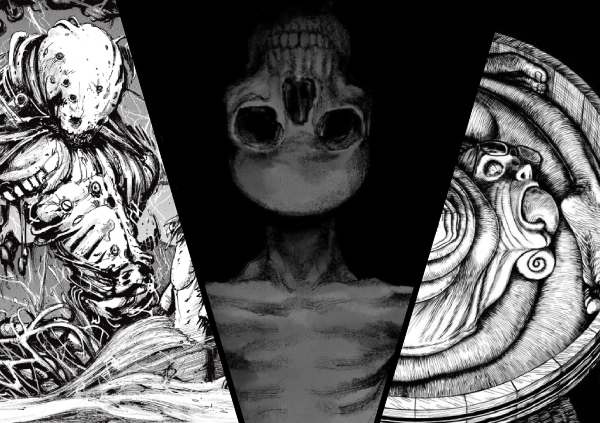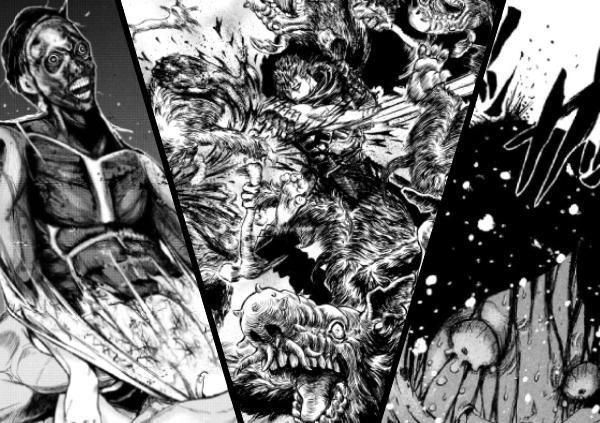As a lifelong fan of cosmic horror, I’ve always been drawn to stories that don’t just frighten, but deeply unsettle you in entirely different ways. Cosmic horror manga do exactly that.
The creeping sense that we’re nothing but a fragile speck in a vast, indifferent universe. I even put together a full list of my favorite H. P. Lovecraft stories as a testament to my love of the genre.
Whether it’s fiction, film or manga, I devour anything that explores the unknown. Cosmic horror is one of the most difficult forms of horror to pull off, especially in manga. The medium excels at monsters and gore, but only a handful of works truly embrace the dread of incomprehensible forces, inevitable collapse, and mind-shattering revelations.
That’s what this list is about.
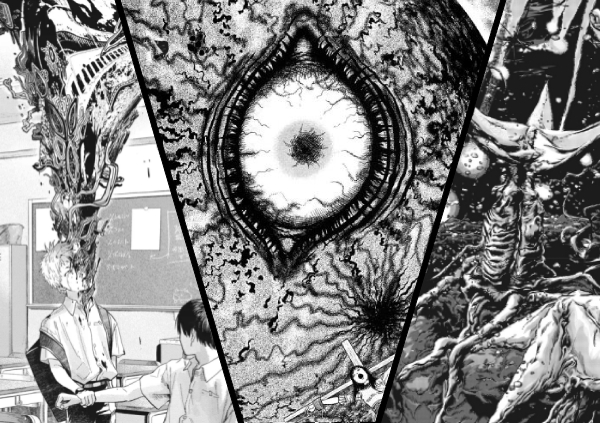
Cosmic horror manga blend surreal art with existential terror. Here logic breaks down, reality bends, and the horror isn’t always a monster. Sometimes, it’s the realization that nothing makes sense anymore. What begins as unease spirals into obsession, madness, and collapse.
While it’s much shorter than my best horror manga list, every title here earns its place. These manga capture the essence of cosmic horror, the fear of the void, the madness of truth, and the slow spiral into something worse than death. Some offer existential sci-fi, others present surreal nightmares and eldritch horrors.
So if you’re a fan of cosmic horror, and look for manga that actually make you fear the unknown, then these titles are the ones to read.
Mild spoiler warning: I keep things vague, but sometimes it’s unavoidable.
Here’s my curated list of the best cosmic horror manga I ever read (last updated: July 2025).
9. Knights of Sidonia
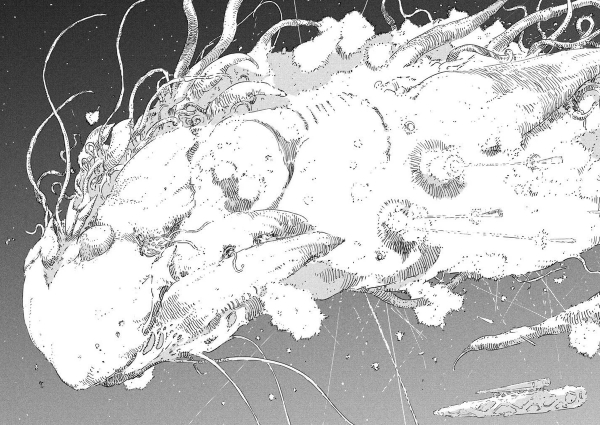
Knights of Sidonia is Tsutomu Nihei’s most accessible work. It’s a science-fiction epic set in a future where humanity drifts through space aboard massive seed ships, desperately fleeing from a mysterious alien race known as the Gauna.
On the surface, this might look like your standard space opera, complete with mechas and military drama, but make no mistake: Knights of Sidonia is deeply rooted in cosmic horror.
The premise alone feels Lovecraftian. Earth is destroyed, humanity is scattered, and survives only by staying ahead of an incomprehensible enemy. The Gauna aren’t simply alien; they are other. Shifting, tentacled monstrosities composed of bizarre organic structures: an outer placenta and an inner true body. They defy reason and never offer an explanation. Their motives are opaque, their inner biology impossible to grasp. Even their capacity to mimic the human form creates a disturbing blend of body horror and uncanny valley.
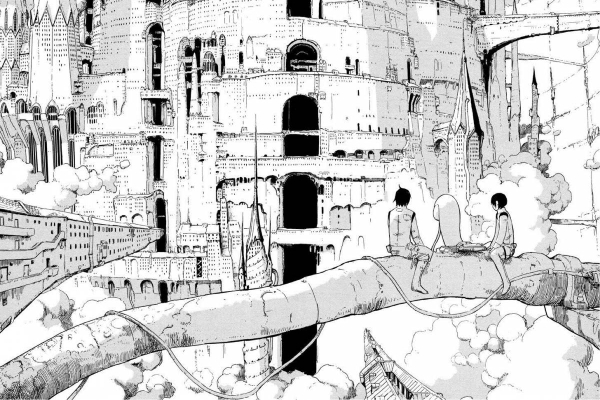
That’s the brilliance of Knights of Sidonia. It’s not about overcoming the unknown. It’s about surviving it. The Sidonia isn’t humanity’s last hope. It’s just one ship trying to outrun annihilation. Victory isn’t about defeating the Gauna. It’s about outlasting their relentless assaults. That existential helplessness, the cosmic scale of conflict, is what gives the series its horror edge.
In typical Nihei-fashion the manga features impossible structures, disorienting verticality, and cold, brutalist machinery. Yet it trades the isolated nihilism of Blame! for a more character-driven, shonen-inspired tone. There’s comedy, romance, and even hope, something seasoned fans of Nihei’s work might find jarring.
Still, the scale and dread remain. While it might be Nihei’s most mainstream work, it never forgets its roots, and is a cosmic horror manga that actually succeeds.
Genres: Sci-Fi, Cosmic Horror, Action, Psychological
Status: Finished (Seinen)
8. The Summer Hikaru Died
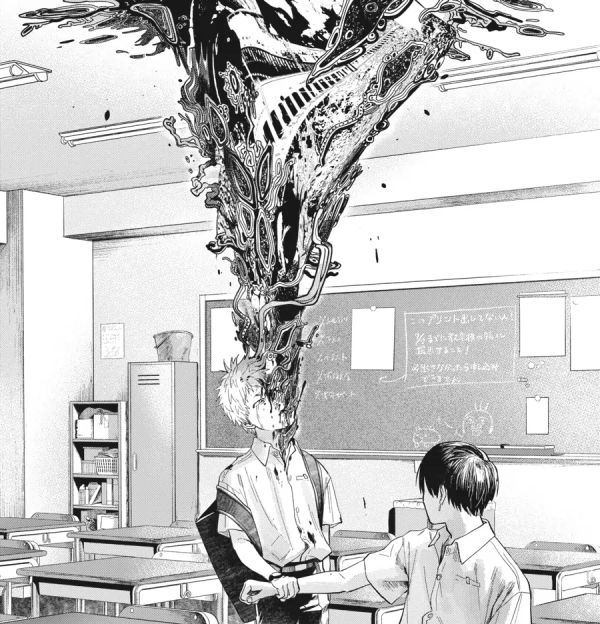
The Summer Hikaru Died is cosmic horror at its most intimate. Ren Mokumokuren blends the emotional weight of a small-town coming-of-age story with the dread of unknowable beings and creeping existential unease.
The story begins simple: Yoshiki, a teenager living in a quiet rural village, knows that his best friend Hikaru is no longer human. He looks like Hikaru, sounds like him, and even remembers personal things only Hikaru would know. Yet he’s something else entirely.
What makes this story cosmic isn’t a looming apocalypse or ancient god, it’s Hikaru himself. His true form, when it emerges, is a vast and alien shape: shifting, pulsating patterns of otherworldly beauty that defy explanation. He’s not a ghost or a monster. Even he doesn’t understand what he is. That ambiguity paired with his connection to Yoshiki is what makes the horror so powerful.
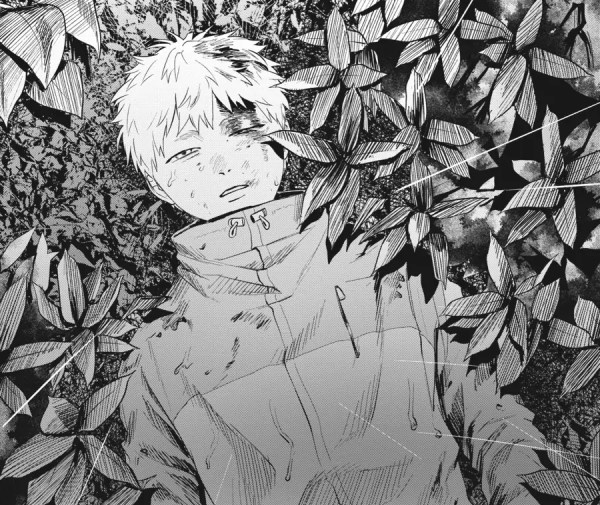
Unlike traditional cosmic horror, The Summer Hikaru Died stays grounded in human emotion. There’s real tenderness here. Yoshiki isn’t just afraid of the thing that replaced Hikaru. He grieves him, loves him, and refuses to let go. Their bond, while deeply unsettling, is also romantic. One early scene, in which Yoshiki plunges his hand into Hikaru’s body, is both horrific and oddly intimate.
The manga also weaves rural folklore, particularly around a mysterious local deity known as Nounuki-sama. Yet at its core, it’s a story about identity, and the quiet, cosmic terror of loving something you don’t understand.
Beautiful, eerie, and emotionally complex, The Summer Hikaru Died is a cosmic horror manga unlike any other.
Genres: Horror, Mystery, Supernatural, Cosmic Horror, BL
Status: Ongoing (Seinen)
7. 6000
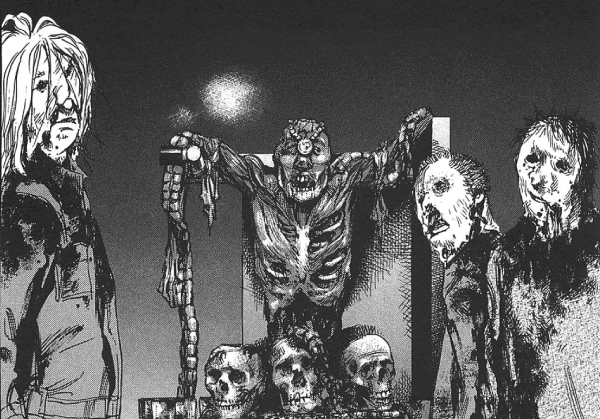
6000 is a claustrophobic descent into deep-sea terror, and one of the few manga that fully embraces the dread of cosmic horror. Set aboard a derelict research facility 6000 meters below the ocean’s surface, it follows a crew sent to investigate a series of mysterious deaths. As they descend, however, reality frays, hallucinations multiply, and something ancient and unknowable begins to stir.
What immediately stands out is the oppressive atmosphere. The art is scratchy, heavy with black ink, and saturated with dread. Every hallway, reflection, and shadow feels slightly wrong. While these earlier chapters are atmospheric, they can still drag on a little, but when the horror finally breaks loose, it’s disturbing in every sense: bloated corpses, cryptic rituals, and glimpses of a Lovecraftian entity beyond comprehension.
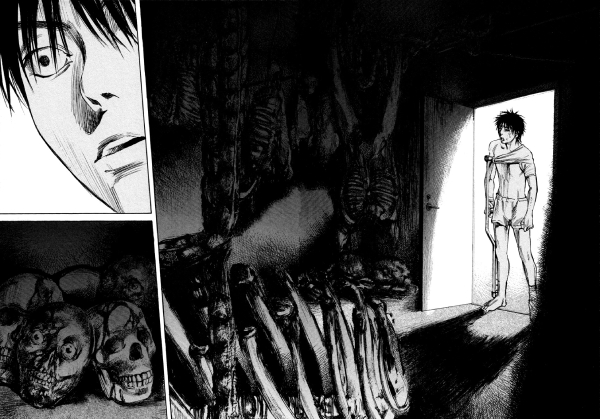
6000 relies heavily on visual storytelling. The sprawling station is disorienting by design, and the panel transition grows increasingly cryptic. Scenes blend together, and events stop making sense. Much of the story unfolds in flashbacks, or dream-like sequences, making it almost indecipherable. Yet this presentation only mirrors the character’s psychological state of mind, as reality erodes around them.
This isn’t a character-driven manga, its plot can feel fragmented, and the progression of events might not always make sense. As a horror experience grounded in cosmic unease, isolation and madness, however, it’s a hidden gem. It’s grim, eerie, and deeply unsettling, and easily one of the few cosmic horror manga who do things right.
Genres: Horror, Psychological, Survival, Cosmic Horror
Status: Finished (Seinen)
6. Soil
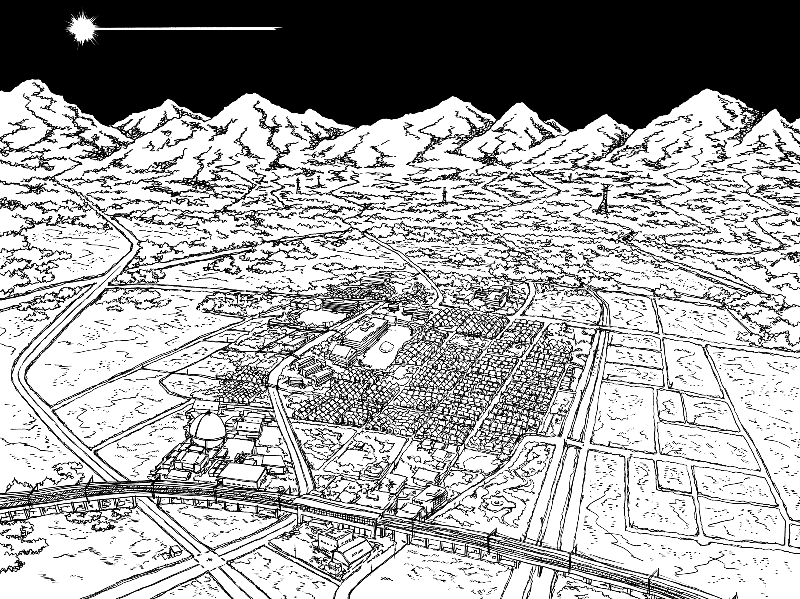
Soil by Atsushi Kaneko is one of the weirdest manga ever created, but that’s exactly what makes it such an unforgettable cosmic experience.
It begins as a grounded mystery. A family vanishes from the perfectly planned utopia of Soil New Town. Two detectives, Yokoi and Onoda, are sent to investigate. At first, it reads like a slow-burn crime thriller. But soon things start to twist. Events stop making sense. The case spirals into something far, far stranger, and Soil transforms into a Lovecraftian fever dream.
Yet Soil isn’t your typical cosmic horror manga. It isn’t about tentacled gods or eldritch abominations. Its horror lies in the breakdown of logic, narrative, and reality itself. The mystery becomes surreal; the town begins to warp, and the rules no longer apply. In one unforgettable scene later in the manga, Yokoi passes through an entirely alien realm, showcasing just how surreal and bizarre the manga has become.
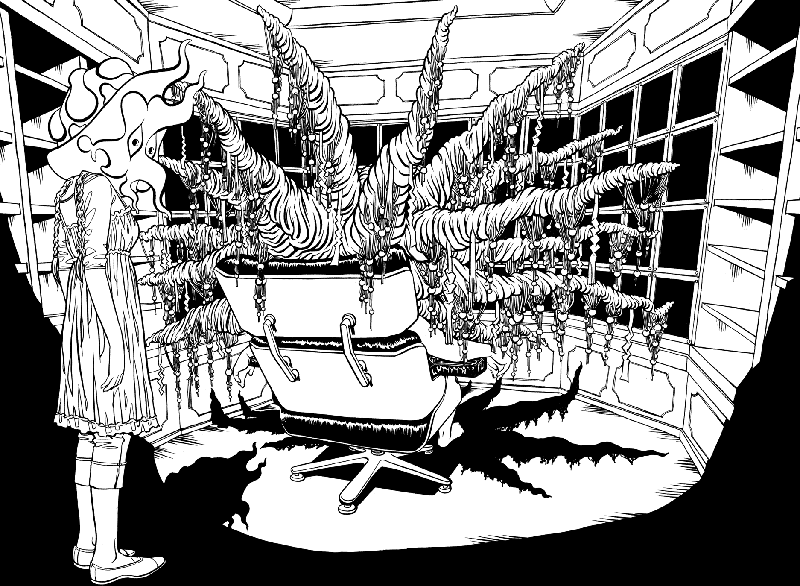
The artwork reflects this unraveling. What begins as stiff, diagrammatic linework quickly descends into grotesque, chaotic expressionism. Faces twist and panels distort as the story’s structure collapses. By the final volumes, Soil abandons answers entirely. You’re left with atmosphere, dread, and the sinking feeling that nothing you saw made sense, and that’s by design.
That’s what makes Soil such a standout in the world of cosmic horror manga. It doesn’t explain the unknown; it drags you straight into it. Not with monsters, but with pure, disorienting madness. It’s the horrifying unraveling of reality, and the terrifying realization there’s no way back.
Genres: Horror, Crime, Mystery, Psychological, Philosophical
Status: Finished (Seinen)
5. Wakusei Closet

Wakusei Closet beings like a dream, but soon after, a boy turns into a grotesque monster.
From its very first chapter, the manga throws you off-balance. Aimi, an ordinary schoolgirl, finds herself transported to a surreal alien world whenever she falls asleep. There she meets Flare, another girl trapped in this dreamlike landscape.
The art is soft and whimsical at first: rounded faces, glowing skies, moments of levity. Then the gentle aesthetic gives way to something far more terrifying.
One of Aimi’s classmates is devoured in the real world and seemingly appears in same alien realm Flare inhabits. There he’s reborn as a fleshy, tentacled monstrosity. From that moment on, Wakusei Closet fully embraces its true identity as a cosmic horror manga.

The contrast is jarring. The manga’s clean, moe-influenced art clashes with its creeping horror: parasitic infection, bodily transformation, and reality-bending monstrosities. While the girls try to find a way to bring Flare back to Earth, they soon learn more about the alien planet, its inhabitants, and the threat it poses. Not only for them, but the real world.
Wakusei Closet isn’t just a story about strange realms and escape, but about true cosmic and Lovecraftian terror.
And just when you think it’s over, when all the answers seem to be revealed, the manga pulls one of the most mind-bending twists I’ve ever read.
Surreal, eerie, and emotionally raw, Wakusei Closet is a standout cosmic horror manga that deserves much more attention than it gets.
Genres: Horror, Fantasy, Supernatural, Cosmic Horror, Shojo Ai
Status: Finished (Seinen)
4. The Enigma at Amigara Fault
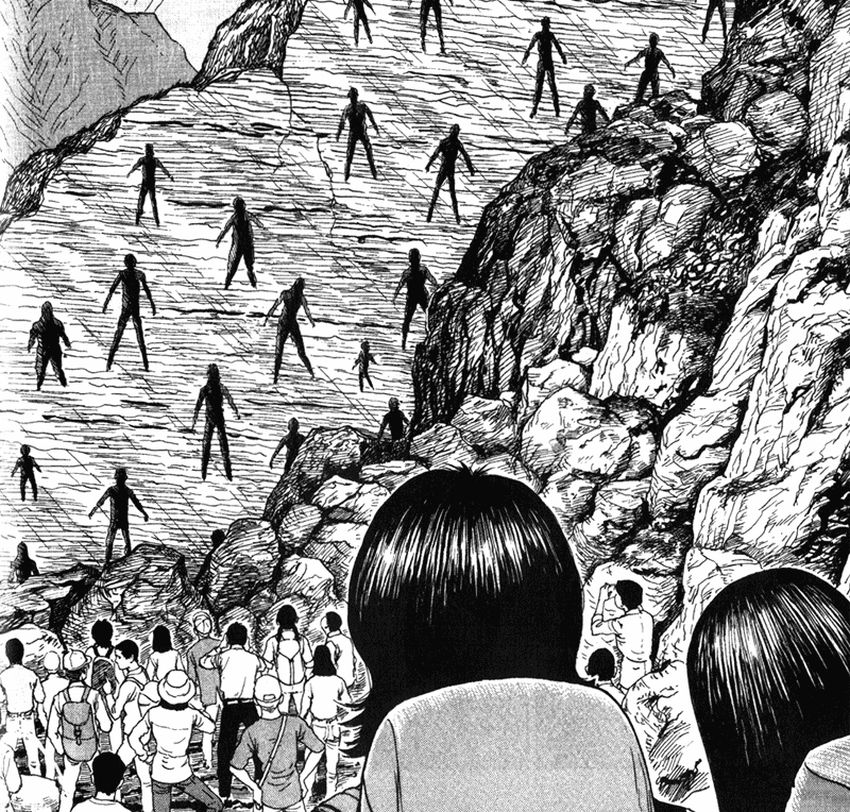
The Enigma of Amigara Fault may not feature ancient gods or tentacled creatures, but it is still one of the most effective pieces of cosmic horror ever written.
After an earthquake reveals a mysterious fault line carved with human-shaped holes, people across Japan travel to the site, believing one of the holes to be made specifically for them. It’s an absurd premise, at least, until the compulsion sets in. One by one, individuals enter their personal holes, disappearing into the mountain. No one knows where the holes came from, or where they lead. Yet they enter anyway.
That’s the horror: not what’s inside the mountain, but the part of you that wants to go.
There are no monsters here. No over threats. Just something deeply unknowable, something that calls to you without explanation. The horror isn’t external. It’s existential. The holes are inexplicable, and yet they feel inevitable. Every person who finds their hole feels compelled to enter, driven by a force they can’t understand or resist.
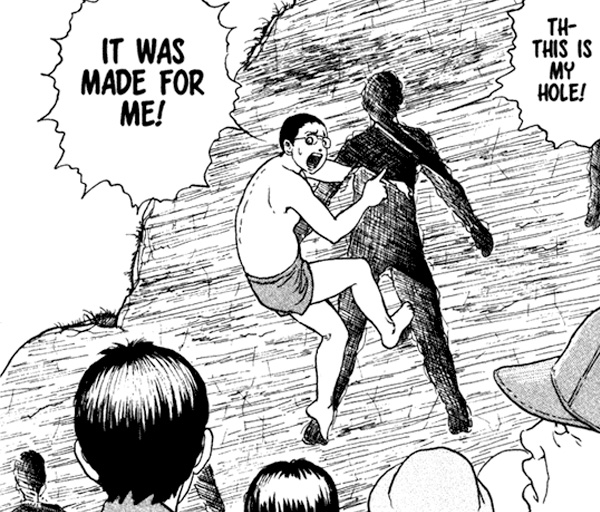
This is where The Enigma of Amigara Fault becomes pure cosmic horror. The story isn’t about answers. It’s about how the mind reacts to the unknown. How it rationalizes, succumbs, and ultimately breaks under the weight of something that refuses to be explained.
Junji Ito’s art heightens this effect. With nothing but a cliff face, some shadows, and increasingly erratic expressions, he builds one of the most unforgettable, creeping atmospheres in horror manga.
The Enigma of Amigara Fault is a masterclass in restraint. It shows us that the most terrifying thing in the world isn’t death, it’s the irresistible pull of something you can’t understand.
Genres: Horror, Psychological
Status: Finished (Oneshot)
3. Uzumaki
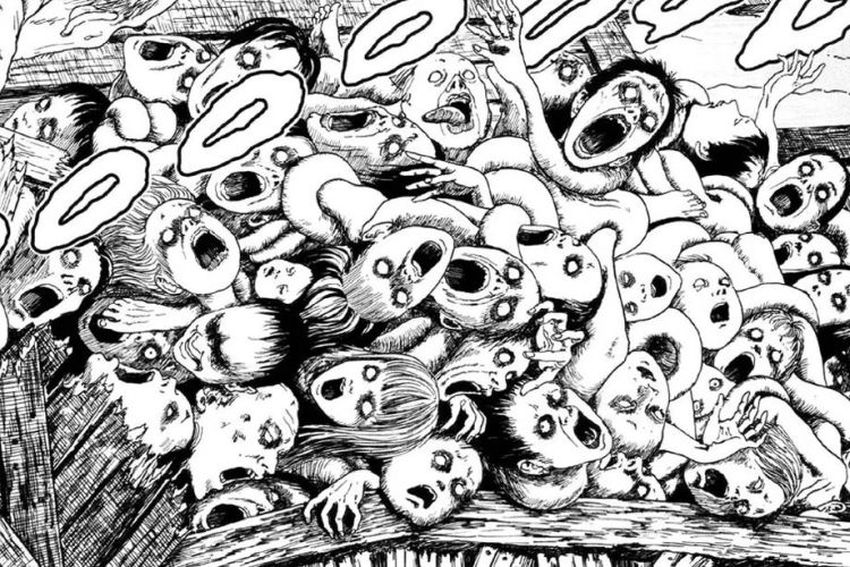
Uzumaki is Junji Ito’s crowning achievement, and one of the most unforgettable works of cosmic horror manga ever written.
Set in the coastal town of Kurouzu-cho, Uzumaki follows Kirie and her boyfriend Shuichi as their town slowly falls under the influence of a curse. Yet it isn’t a curse in the traditional sense. There are no monsters to defeat, no villains to confront. The enemy is nothing but a concept: the spiral.
The spiral soon infects the townspeople. Subtle at first, like Shuichi’s father, who grows obsessed with spiral-shaped objects. Yet with each chapter, the madness spreads, and the transformations become more surreal and violent. People’s bodies are contorted into impossible forms and twisted into grotesque husks.

What makes Uzumaki so terrifying isn’t just the imagery, but its concept. The spiral isn’t a creature; it isn’t evil, not even sentient. It simply is. It’s a natural force beyond understanding, whose mere existence dooms all who encounter it. That’s what makes it pure cosmic horror. It’s not just that the characters can’t stop what’s happening, they can’t even comprehend why it is happening.
Junji Ito’s art is at its best here. Every page is dripping with tension and dread, slowly building a nightmare that escalates from eerie to apocalyptic.
While Uzumaki has its flaws, the episodic structure, a passive protagonist, and a final explanation that tries a bit too much, none of these diminishes its impact. This is horror as a concept, horror as a fate. You don’t fight the spiral. You’re drawn into it, slowly, but inevitably.
Beautiful, grotesque, and utterly unique, Uzumaki is a hypnotic descent into cosmic madness. It’s a modern horror masterpiece.
Genres: Horror, Supernatural, Mystery, Cosmic Horror
Status: Finished (Seinen)
2. Hellstar Remina
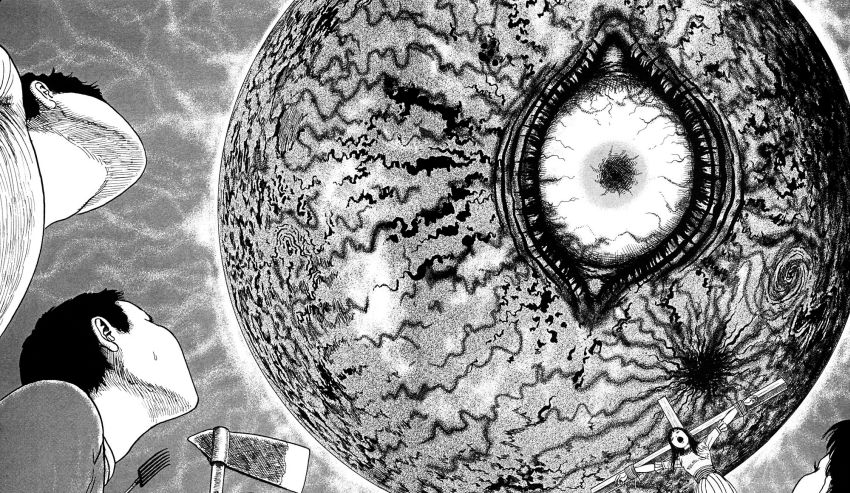
Hellstar Remina is Junji Ito’s most overtly Lovecraftian work, and the closest he’s come to crafting pure cosmic horror on a truly apocalyptic scale.
The story begins when Professor Oguro discovers a wormhole, and then a mysterious new planet that enters our universe through it. He names the planet Remina, after his daughter. At first, the discovery is celebrated, and Remina becomes a national sensation. Excitement quickly turns to dread, however. The planet doesn’t follow any natural orbit. It moves of its own will, and wherever it goes, stars vanish.
Soon, it becomes clear: the planet is alive. Worse, it’s heading straight for Earth, destroying every celestial body in its path. What begins as scientific discovery becomes planetary doom as Hellstar Remina tears through the solar system, devouring worlds before finally setting its gaze on humanity.

This isn’t just horror. It’s cosmic horror in its truest sense. The antagonist is a sentient planet, an eldritch abomination whose very existence shatters all logic. The scale here is so vast, it’s almost absurd. What we witness is the universe collapsing beneath an incomprehensible, malevolent force.
As Earth unravels, panic erupts. But Ito focuses much on humanity’s descent into madness. Mass hysteria, cult-like fervor, and a frenzied manhunt for the professor’s daughter.
The real draw, however, is the art. The design of Hellstar Remina is unforgettable. It’s a planetary mass with a gaping maw, a staring eye, and a surface that’s alive. The imagery is pure nightmare fuel: colossal, surreal, and deeply disturbing.
While the plot eventually devolves into near-comic levels of hysteria, Hellstar Remina remains one of Ito’s most memorable works. If you want Lovecraftian horror at galactic scale, this is it.
Genres: Horror, Cosmic Horror, Psychological, Apocalyptic
Status: Finished (Seinen)
1. At the Mountains of Madness
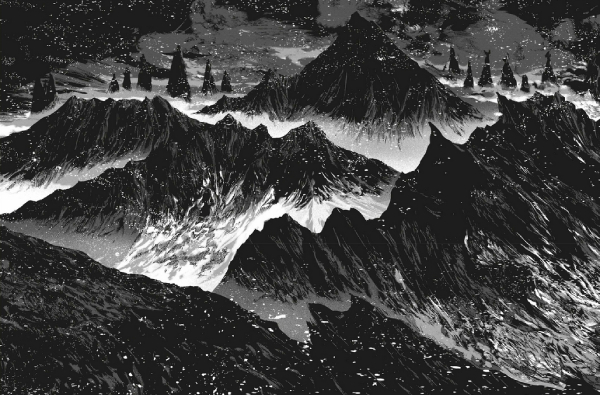
At the Mountains of Madness is arguably H. P. Lovecraft’s most iconic work, and Gou Tanabe’s manga adaption stands as one of the finest examples of cosmic horror manga ever created.
The story follows Dr. William Dyer of Miskatonic University’s ill-fated Antarctic expedition. His goal is not glory or discovery, but to recount the truth of what his team unearthed beneath the ice, so no one ever dares to follow his footsteps.
What begins as a slow, scientific-expedition soon spirals into existential terror. The team uncovers remnants of a pre-human civilization and fossilized creatures that defy all classification. The deeper they go, however, the clearer it becomes that the ruins aren’t abandoned. Something ancient, and utterly alien, still stirs beneath the ice.

This is cosmic horror in the truest Lovecraftian sense: a journey into isolation, madness, and the realization of mankind’s insignificance in the face of incomprehensible, godlike forces.
Gou Tanabe’s artwork captures all of this with chilling precision. His hyper-detailed linework, stark shadows, and sweeping vistas of Antarctica create an atmosphere of dread and awe. Massiv panels depict impossible architecture and inhuman forms. When the monsters are finally revealed, their appearance is majestic and grotesque, exactly as Lovecraft intended.
Few artists have ever translated Lovecraft’s dread into visual media as effectively as Tanabe. His pacing is slow, deliberate, and suffocating in the best way. This is not just an adaption. It’s a faithful tribute to the scale, fear, and insignificance that defines cosmic horror.
If you’re a fan of Lovecraft, of cosmic horror, or just slow-burn existential dread, At the Mountains of Madness is a must-read.
Genres: Horror, Mystery, Sci-Fi, Supernatural, Cosmic Horror
Status: Finished (Seinen)
